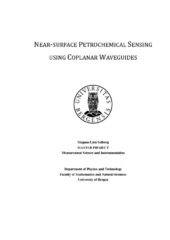Near-surface petrochemical sensing using coplanar waveguides
Master thesis
Permanent lenke
https://hdl.handle.net/1956/10682Utgivelsesdato
2015-09-11Metadata
Vis full innførselSamlinger
Sammendrag
The project studies the ability of coplanar waveguide sensor in sensing thin layers of petrochemical liquid. A coplanar waveguide is built on flexible printable circuit board partially based on an existing design. Two sensors are constructed with the coplanar waveguide to test the industrial applicability of sensor mounted on the inside of pipe wall. Simulation tool are used to examine the viability of incorporating simulation in microwave frequency experiments and sensor design. The experiments focus on performance of the sensors and place emphasis on the measurement output of liquid with non-uniform thickness. The test liquid stays above the entire surface of the coplanar waveguide sensor. At the side of the sensor, a vertical transition is implemented to connect coplanar waveguide to coaxial one. Microwave frequency range signal is excited at the ports, and interacts with the liquid as it is transmitted on the coplanar waveguide. The effective permittivity, influenced by both the thickness and the permittivity of the test liquid above the coplanar waveguide, affects the characteristic of the transmission of the wave between the ports. Thus, the measured S-parameters can be used to interpret the permittivity. The sensors in the project produce more accurate permittivity measurements than the old prototype for frequencies below 200 MHz. The viability of coplanar waveguide built on flexible printed circuit board is therefore verified as effective in near-surface permittivity measurements. Bending of the coplanar waveguide has minimum influence on the measurements. It is therefore concluded that it should be possible to place it in-line on the pipe wall. The simulation software is confirmed to be stable in producing realistic result within the frequency range and permittivity range in the project. Non-uniform thin layers of the petroleum products can be measured by permittivity measurement using the coplanar waveguide sensors. A small change in effective permittivity caused by thickness variation can be detected regardless of the type of test liquid. The calculated effective permittivity of test liquid does not vary as long as the average thickness across the sensor area is the same. The thickness non-uniformity therefore does not affect significantly the effective permittivity of the test liquid.
